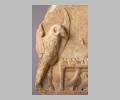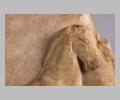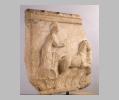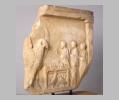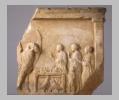| Collection: | Museum of Fine Arts, Boston |
| Title: | Two-sided Votive Relief to Helios and to Men |
| Context: | Possibly from Attica |
| Summary: | On one side, Helios driving the four-horse chariot of the sun; on the other side, Men seated side-saddle (?) on a large ram at an offering table to which four worshippers approach |
| Object Function: | Votive |
| Material: | Marble |
| Sculpture Type: | Stele, relief-decorated |
| Category: | Single sculpture |
| Style: | Late Classical |
| Technique: | Low relief |
| Original or Copy: | Original |
| Date: | ca. 340 BC |
| Dimensions: | H. 0.45 m, W. 0. 445 m |
| Scale: | Miniature (pictorial field) |
| Region: | Attica |
| Period: | Late Classical |
Subject Description:
On side A, Helios, the personfication of the sun, dressed as a charioteer in a long flowing chiton, bound just above the waist, and short hair, rides a quadriga, or four-horse chariot, profile to the right (although the front of the spoked wheel of the chariot is shown to emerge slightly from the surface of the relief). Helios is also identified by a solar disk, which is on the relief surface behind his head.
On side B, Men, a moon god from Asia Minor (broken off but indicated by the lunar crescent, behind his body), is seated presumably in a 3/4-view to the right, on the back of the ram, shown profile to the right. In front of them is a sacrificial table piled with fruit and cakes, beneath which stand two birds. On the other side four humans, shown on a smaller scale (three adults and one child), advance to pay homage to the god. The cult of Men was introduced to Attika shortly after 400 B.C.
Form & Style:
The relief is framed by two antae (one of which is preserved), supporting a roof with antefixes (parts of four antefixes are preserved), and a plinth below the pictorial field.
Comstock & Vermeule associate this relief with the artists responsible for the frieze of charioteers on the Mausolleion of Halikarnassos (compare
Condition: Intact
Condition Description: One large fragment, preserving most of one side of the relief, comprising the left half of side a, and the right half of side b. The relief is also broken in the lower left corner, and severely cracked in the upper left; the surface is well preserved, however, somewhat yellowed, with slight chips and stains.
Material Description:
Fine-grained 'Pentelic' (Comstock & Vermeule)
Inscription: On the architrave are traces of a votive inscription, on side A
Inscription Bibliography: SEG 28.233
Collection History: Formerly in the Collection of Count K. Lanckoronski, Vienna. Acquired by the MFA in 1972.
Sources Used:
Other Bibliography: IstMitt 30 (1980) 275-76.
